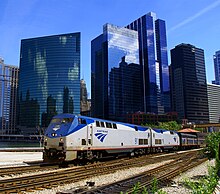Transportation in Chicago
Mass transit in much of the Chicago metropolitan area is managed through the Regional Transportation Authority (RTA), which was installed by a referendum in 1974.
The RTA provides transportation services through the funding of three subordinate agencies: the Chicago Transit Authority, Metra, and Pace.
Chicago maintains a 290-mile network of bikeways - including shared use paths, cycle tracks, and bike lanes - for private, public, and commercial bicycle use.
Bicycles are available for rent at rental shops concentrated along the lakefront in the Loop and Near North Side community areas.
[5] Bicycles are allowed onboard Metra commuter rail service during off-peak and non-event times and in reverse peak directions during rush hours.
[6] Bicycles are only allowed on designated South Shore Line commuter rail service trains as part of a pilot program active during non-winter months.
Greyhound Lines operates the majority of the intercity bus service to and from Chicago, with routes connecting Chicago with Indianapolis, Cincinnati, Louisville, Nashville, Atlanta, Cleveland, Pittsburgh, Washington, New York, Detroit, Toronto, Milwaukee, Green Bay, Madison, Minneapolis, St. Louis, Memphis, intermediate points, and connecting with other points beyond.
Megabus, a subsidiary of Coach USA, departs from a curbside bus stop near Union Station, on Canal Street south of Jackson Boulevard, and connects Chicago with Indianapolis, Cincinnati, Louisville, Nashville, Cleveland, Columbus, Cleveland, Detroit, Milwaukee, Madison, Minneapolis, Des Moines, Omaha, St. Louis, Memphis, Kansas City, intermediate points, and connecting with other points beyond.
The Metra Electric District is Chicago's oldest continuing commuter train (1856), and shares the railway with the South Shore Line, operated by the Northern Indiana Commuter Transit District (NICTD), which is a separate but analogous quasi-governmental entity, partially funded by the RTA.
Amtrak owns and operates Union Station, the fourth-largest intercity passenger hub in the United States.
They ran every 20 to 30 minutes and served areas popular with tourists that did not have 'L' stations, such as the Museum Campus, Navy Pier, and the Magnificent Mile.
Chicago taxi regulations were revamped in a 2012 reform package backed by Mayor Rahm Emanuel; the package raised the "flag pull" initial hire charge by $1, mandated credit card readers and GPS, and placed new limits on fleet age.
[20] Chicago waterways are used extensively for commercial shipping, passenger ferry service, and recreational boating.
[21] Passenger ferry service in Chicago is handled by commercial water taxis operating on defined routes on published schedules.
Shoreline Sightseeing offers water taxi service along the Chicago River with stops at Navy Pier, Michigan Avenue, and Adams Street.
This traffic originates from numerous private and commercial marinas and slips, and the Chicago Park District operates a municipal harbor system for the seasonal storage of recreational watercraft in Lake Michigan.






